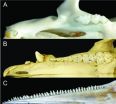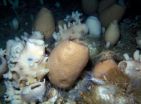(Press-News.org) International marine scientists today warned it will be vital to protect key marine turtle nesting grounds and areas that may be suitable for turtle nesting in the future to ensure that the marine reptiles have a better chance of withstanding climate change.
A new study reveals that some turtle populations in the West Indian Ocean, Northeast Indian Ocean, North Pacific Ocean, East Atlantic Ocean and the East Pacific Ocean are among the least likely to recover from the impacts of climate change. Mariana_19feb_2
"To give marine turtles a better chance of coping with climate change, we have to protect their nesting sites and to address threats such as bycatch and coastal development," says Dr Mariana Fuentes from the ARC Centres of Excellence for Coral Reef Studies (CoECRS) and James Cook University.
"We have seen sea turtle populations decline dramatically in recent decades, and it is likely to get worse due to climate change, as they're particularly vulnerable to it.
"Climate change can affect their nesting beaches through sea level rise, stronger cyclones and storms; high temperatures can cause their eggs to die before they hatch, or produce an unnatural sex ratio and adversely affect their food sources."
"At present there are three ways we can tackle climate-related threats," Dr Fuentes says. "We can reduce global greenhouse emissions, actively manage for direct impacts from climate change by manipulating the nesting thermal environment with shade, for example, and build the turtles' resilience, that is, their ability to recover from the negative impacts.
"Reducing emissions is perhaps the biggest challenge, but even if we were able to cut greenhouse emissions immediately, it will not stop the already apparent and unavoidable impacts of climate change on turtles."
"Also, we don't know the risks of implementing actions, such as relocating, manipulating or managing turtle populations, or how effective these strategies are," she says. "So until we understand more about the risks and effects of active strategies, we should focus on increasing the turtles' resilience. Mariana_19Feb_1
"This means that we must better understand what factors influence their ability to recover from the negative effects of climate change."
Together with sea turtle specialists from around the world, the CoECRS researchers identified that nesting ground vulnerability and non-climate threats, including coastal development and fishery bycatch, as the greatest influences on resilience of marine turtles to climate change.
The researchers also pinpointed the world's 13 turtle regional management units – large scale conservation areas – that are the least resilient to climate change. These are distributed across three major ocean basins and are important breeding grounds for six of the world's seven species of sea turtle – flatbacks, loggerheads, green turtles, leatherbacks, hawksbills, olive ridleys and Kemp's ridleys.
"Eleven of the least resilient conservation areas that we identified are the ones most likely to lose their turtle rookeries," Dr Fuentes says. "This highlights the particular importance of protecting key regional nesting beaches and to legally protect areas that may be suitable for turtle nesting in the future.
"Turtles have existed for millions of years and were here long before humans. It would be a complete tragedy if they were to become extinct as a result of our actions and our lack of care."
###
The study "Resilience of marine turtle regional management units to climate change" by Fuentes MMPB, Pike DA, Dimattero A and Wallace BP is published in Global Change Biology. See: http://onlinelibrary.wiley.com/doi/10.1111/gcb.12138/abstract
More information:
Dr Mariana Fuentes, CoECRS and JCU, ph + 61 (0)7 4781 5270 or 0411 645 986
Jenny Lappin, CoECRS, ph +61 (0)7 4781 4222
Jim O'Brien, JCU, ph +61 (0)7 4781 4822 or 0418 892449
http://www.coralcoe.org.au/
Nesting site protection 'key to save turtles from climate change'
2013-02-19
ELSE PRESS RELEASES FROM THIS DATE:
5-ALA fluorescence guides resection of recurrent glioblastoma multiforme
2013-02-19
Charlottesville, VA, February 19, 2013. Neurosurgeons from UC San Francisco describe the use of 5-aminolevulinic acid (5-ALA) fluorescence in guiding resection of recurrent glioblastoma multiforme (GBM). Ingestion of 5-ALA by a patient before surgery leads to fluorescence of tumor cells intraoperatively in response to certain wavelengths of light. This can provide information not necessarily available through magnetic resonance imaging (MRI), the standard mode of imaging used to detect primary and recurrent GBMs. The additional information provided by 5-ALA fluorescence ...
How the whale got its teeth
2013-02-19
Whales are mammals, but they don't look like the mammals living around us, as they have a triangular fluke for tail, no hind legs and no body hair. And inside their mouths, their teeth are unfamiliar too – being much simpler and 'peg like'. A multidisciplinary team of researchers have now married together the fossil record and the embryonic development process to investigate how the whale got its teeth.
Most mammals have four kinds of teeth, each shaped for specific tasks. In most mammals there are wedge-shaped incisors, a pointy canine, and premolars and molars with ...
Stillbirth in Inuit and First Nations women higher than for non-Aboriginal residents
2013-02-19
Stillbirth rates in First Nations and Inuit populations in Quebec are higher than in the general population, especially in late gestation and at term, found a new study in CMAJ (Canadian Medical Association Journal).
"Aboriginal populations in Canada [First Nations and Inuit] rank at the top of the list of disadvantaged groups with the highest rates of stillbirth in the Western world," writes Dr. Nathalie Auger, Institut national de santé publique du Québec, with coauthors. Rates are 2 times those of the non-Aboriginal population.
Researchers looked at data on 9983 ...
Unplanned hospitalization more likely in people with several illnesses, mental health conditions
2013-02-19
People with multiple illnesses are much more likely to be admitted to hospital unexpectedly, and mental health issues and economic hardship further increase the likelihood, according to a study in CMAJ (Canadian Medical Association Journal).
"We provide strong evidence that physical multimorbidity substantially affects the use of acute hospital services, including admissions considered potentially preventable through management of optimal primary care," writes Dr. Rupert Payne, Cambridge Centre for Health Services Research, University of Cambridge, Cambridge, United Kingdom. ...
There's room for improvement in women's heart disease awareness
2013-02-19
The number of women aware that heart disease is the leading cause of death has nearly doubled in the last 15 years, but that knowledge still lags in minorities and younger women, according to a new study in the American Heart Association journal Circulation.
Researchers comparing women's views about heart disease in 1997 and today, found:
In 2012, 56 percent of women identified heart disease as the leading cause of death compared with 30 percent in 1997.
In 1997, women were more likely to cite cancer than heart disease as the leading killer (35 percent versus 30 ...
Data paper describes Antarctic biodiversity data gathered by 90 expeditions since 1956
2013-02-19
A new peer-reviewed data paper offers a comprehensive, open-access collection of georeferenced biological information about the Antarctic macrobenthic communities. The term macrobenthic refers to the visible-for-the-eye organisms that live near or on the sea bottom such as echinoderms, sponges, ascidians, crustaceans. The paper will help in coordinating biodiversity research and conservation activities on species living near the ocean bottom of the Antarctic.
The data paper "Antarctic macrobenthic communities: A compilation of circumpolar information", published in the ...
Phosphorus starvation linked to symptoms of citrus disease Huanglongbing in new study
2013-02-19
The citrus disease Huanglongbing (HLB), meaning "yellow shoot disease" in Chinese and also called citrus greening in English-speaking countries, is the most destructive disease threatening the citrus industry worldwide. Powerful diagnostic tools and management strategies are desired to control it. A new study, 'Small RNA profiling reveals phosphorus deficiency as a contributing factor in symptom expression for citrus Huanglongbing disease', published online today (Friday) in the journal Molecular Plant profiled small Ribonucleic Acids (sRNAs) from both diseased and healthy ...
Moffitt researchers say silencing of retinoblastoma gene regulates differentiation of myeloid cells
2013-02-19
Researchers at the Moffitt Cancer Center have found a potential mechanism by which immune suppressive myeloid-derived suppressor cells can prevent immune response from developing in cancer. This mechanism includes silencing the tumor suppressor gene retinoblastoma 1 or Rb1. Their data explains a new regulatory mechanism by which myeloid-derived suppressor cells are expanded in cancer.
Their study appeared in a recent issue of Nature Immunology.
According to the authors, two kinds of myeloid-derived suppressor cells - monocytic M-MDSCs and granulocytic PMN-MDSCs - regulate ...
New scorpion discovery near metropolitan Tucson, Arizona
2013-02-19
A new species of scorpion, Vaejovis brysoni, was found in the Santa Catalina Mountains in southern Arizona. Another scorpion of the same group also inhabits this mountain range, making this the first documented case of two vorhiesi group species distributed on the same mountain. The study was published in the open access, peer-reviewed journal Zookeys.
These mountains overlook the city of Tucson, Arizona. Amazingly, in the 21st century, there are still new species to be discovered right here in the United States. What is even more surprising is that the new species was ...
Using mouthrinse reduces plaque and gingivitis more than toothbrushing alone
2013-02-19
CHICAGO (Feb. 19, 2013)—New research published in the January/February 2013 issue of General Dentistry, the peer-reviewed clinical journal of the Academy of General Dentistry (AGD), indicates that the use of a germ-killing mouthrinse in addition to regular toothbrushing can significantly reduce plaque and gingivitis, more so than brushing alone.
"It's simple—mouthrinses can reach nearly 100 percent of the mouth's surfaces, while brushing focuses on the teeth, which make up only 25 percent of the mouth," says Christine A. Charles, RDH, BS, lead author of the study and ...


